zoology
1/125
There's no tags or description
Looks like no tags are added yet.
Name | Mastery | Learn | Test | Matching | Spaced |
|---|
No study sessions yet.
126 Terms
characteristics of vertebrates
integument layers- epidermis and dermis
distinctive cartilage or bone (endoskeleton w/vertebrae)
cranium
circulatory system consisting of ventral heart
myomeres
“nothing in biology makes sense except in the light of evolutoin”
believes change through time
Theodosius Dobzhansky
Concepts of animals changing through time dates back to
Anaximander
Darwin proposed what?
a model to explain the process of evolution
where did Darwin get the idea from?
from reverend thomas malthus who an essay about it
Malthus’ observation
human population grows geometrically
food supply doesn’t (it grows exponentially)
more ppl are born than there is food for, not everyone is going to survive
Conclusions of Malthus - concluded by______
Darwin!
concluded that only the fittest survive
fittest
ability to survived and reproduce
success is determined by the number of offspring and the age
Non-amniotes vs amniotes
non amniotes lay their eggs in aquatic environments
-Non-amniotes lack the amnion, a feature of amniotes that protects the embryo from environmental fluctuations. Because of this, amniotes can reproduce on dry land by laying eggs or carrying fertilized eggs within the female.
animals that are amniotes
synapsids (land animals)
mammals
sauropsids (Reptilia)
aves
crocodilia
testudinia
non amniots
hagfish
lamprys
chrondrichthyes
sharks, rays, ratfish
osteichthyes (bony fish)
sarcopterygians
actinopterygians
phylogenetic tree
biological classification reflect evolution
shows relationships of groups we are looking at over time
schools of classfication
numerical taxonomy (phenetics)
evolutionary taxonomy (ecletic system)
phylogenetic systematics (cladistics)
which classification do we use
phylogenetic systematics
who is the phylogenetic systematics developed by
willi henning
how does the PS classify organisms
based on derived characteristics, by evolutionary lineages
clade
evolutionary lineage or branches
apomorphy
new evolved trait
plesiomorphy
old
symplesiomorphy
shared old straight that evolved a long time ago
aka apomorphy shared by different groups
parsimony
criteria used by scientists to determine the fewest steps in the phylogenetic tree
outgroup
a group of organisms not belonging to the group whose evolutionary relationships are being investigated.
ingroup
a group of organisms belonging to the group whose evolutionary relationships are being investigated.
polarity
- The states of characters used in a cladistic analysis, either original or derived.
parsimony
the principle that, out of all possible explanations for a phenomenon, the simplest of the set is most likely to be correct.
homolohgous traits are defined by
common underlying structure and position
Homoplasy
a rare evolutionary event that occurs when the same trait is independently acquired by unrelated organisms
convergence
separate evolution of similar structures in lineages that do not share common ancestry
ex. endothermy in mammals and birds
simple eye in octopus and vertebrae
taxon
naturally evolved group that has a name
ex. aves, primates, mammalia
monophyletic taxon
a group of organisms including a single common ancestor and all the decedents of that ancestor
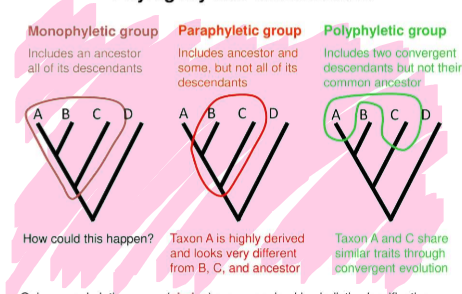
paraphyletic taxon
a group that includes the common ancestor, and some descendants, but not all

polyphyletic taxon
a group that does not include the common ancestry or that includes descendant of more than one ancestry
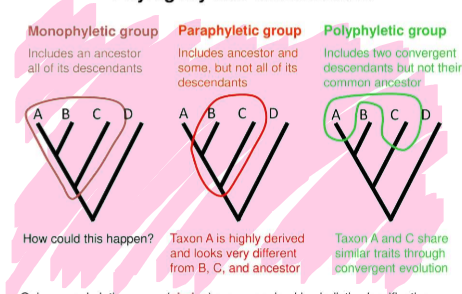
gnathosomes
jawed vertebrates
agnatha
jawless fish
mobility difference in cephalochordates to vertebrates?
muscles changed from V shaped (primitive) to w shaped in vertabraes (derived)
the coloem is developed by the
mesoderm
the coelom is divided into to 2 to 3 sub cavities, what are they?
pleuroperitoneal
pericardial
pleural
(all 3 in mammals)
what is a deuterostome?
their anus forming before the mouth during embryonic development.
are vertebrae deuterostomes?
yes
what are the 3 germinal (triploblastic) layers in vertebrates
ectoderm (forms CNS)
mesoderm
endoderm
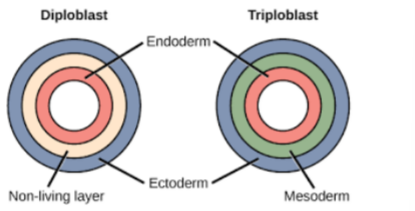
what does the mesoderm form
connective tissue, bones, circulatory system, muscles, urinary, and dermis
what does the endoderm form
part of the digestive system and the endocrine system
types of tissue
epithelial
connective (bone, cartilage, blood)
nervous
muscular
what does the notochord form?
it forms the vertebral column that attaches the axial muscles
axial muscles are composed of?
myomers
horizontal septum does what?
separates myomeres into epaxial (dorsal) and hypaxial (ventral) in jawed vertebrates
types of blood cells?
red blood cells,
white blood cells
platelets/thrombocytes (for stoppage of bleeding) derived from megakarocytes
simple blood circulation/ simple cardiovascular system passage
passes through the heart just one time
blood-sinus venous-atrium-ventricle-conus arteriosum-gills (gas exchange) -body - Starts over again
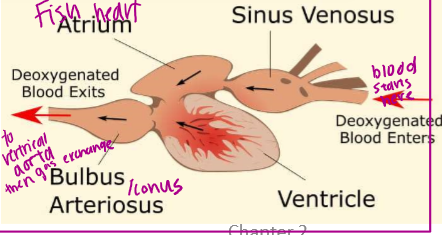
In what animal does simple blood circulation occur?
in aquatic vertabraes
Double circulation passage
passes through the hear 2x
has 2 circuits: Pulmonary & Systematics
body- vena cava-right atrium-right ventricle- lungs- left atrium- left ventricle-aorta- body
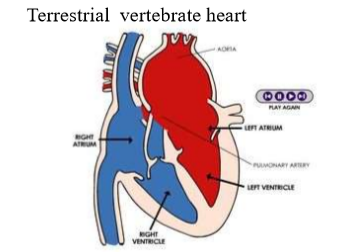
what animals do double circulation happen?
terrestrial vertebrates
How many chambers does a heart with a simple circulation have?
Double circulation?
2
4
why is a fish heart more structurally simple than terrestrial vertebrates?
bc of gravity. fish are considered weightless. there were mustations bc of gravity and the weight that comes with it
excretory system
osmoregulation
a way to maintain body fluids concentration, is developed by the kidneys
why are kidneys different from agnatha to fishes and terrestrials vertebrates
terrestrial vertebrates would lose water and need to prevent it
nervous system includes what systems
central and peripheral systems
what are neurons on the PNS encased in….
the fatty coat, the myelin sheath
What is the PNS composed of
the somatic (voluntary) and visceral (involuntary)
Autonomic Nervous System (ANS) includes
sympathetic nervous system - pump much more blood
parasympathetic nervous system- slows down heart
CNS includes
brain and spinal cord
How does CNS develop? what is the process called?
it developed from an enlargment of the anterior portion of the nerve cord
called cephalization
Why is heat important
every chemical reaction needs a certain range of temperature in order for the body to work
mainly due to enzymes
ectotherm
source of heat is external to the body
endothermy
source of energy is internal to the body
earliest vertebrates are the
ostracoderms and haikouichthys
hagfishes characteristics
elongated body
no dorsal fins
many pharyngeal pouches> 16
marine
filter feeding behavior
direct development, no larval stage
diecious, some monoecious
lamprey characteristics
elongated body
anterior and posterior dorsal fins
freshwater and marine
separated sexes- dioescious
parasites
larval stage, ammocoete
pharyngeal pouches
ostracoderms characteristics
intermediate between jawless and jawed
are jawless but are more derived than lampreys
what makes ostracoderms more derived than lampreys and hagfishes?
dermal bone, aka carapace, a feature in jawed vertebraes
moveable mouth plates, no jaws
true pectoral plates but no jaws
more developed eyes
what is more derived- gnathostomes or agnathans?
gnathostomes
what do developed jaws allow aquatic animals to do?
have a variety of feeding behaviors, food optimization
grasp objects to build nests, mates, and juveniles during parental care
cut food with teeth
explore other feeding behavior (ex. herbivory and carnivory)
evolution of jaws was more efficient for gill ventilation rather than predation
defense
what is the serial theory
first and second branchial arches gave rise to the mandibular arch. The third brachial arch gave rise to the hyoid arch and the rest of the branchial arches to the branchial arches of gnathostomes.

what is the composite theory
10 branchial arches were present in primitive species gave rise to the mandibular arch. All arches were used to make the mandibular arch
the jaws origin was more complex involving the fusion and losses of branchial arches that came together and formed jaws
2 ways to obtain oxygen from water
buccal pumping
ram ventilation
some can have both
what is buccal pumping
creates positive pressure by slowly opening and closing mouth
what is ram ventilation
some open their mouth permanently to gather water(sharks, swordfish)
gill anatomy includes
gill arch
primary lamellae
afferent arteriole
efferent arteriole
operculum what does it do and what is its purpose?
creates pressure so that the pressure inside the mouth is higher than the outside.
forces gas to separate from the water
Countercurrent exchange
a mechanism that occurs when fluids flowing in opposite directions exchange heat or chemicals through a permeable barrier.

what are the air respiratory structures fishes use in water with low oxygen content?
lungs
enlarged lips
vascularized chambers at the rear of the head
what did lungs appear/develop in fishes as
outpockets of the pharyngeal region of the digestive tract
what are the 2 possible locations of the lungs
ventral surface of the gut (lungfishes tetra pods)
dorsal surface of the gut (derived bony fishes)
do lungs require a large surface area?
yes
How do most fishes change buoyancy?
by holding air inside their body
via lungs (teleost fishes) , swim bladder(teleost fishes) , or altering their air volume in their lungs (marine mammals)
how do teleost regulate swim bladder volume?
secreting gas into the swim bladder when going down
removing gas from swim bladder when going to surface
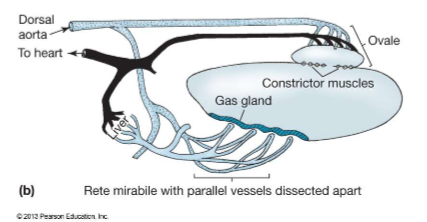
why do teleost regulate swim bladder volume?
to counteract external pressure
Swim bladder can be connected by the ____________ to the ______________
Swim bladder can be connected by the pneumatic duct aka physostomus to the intestines
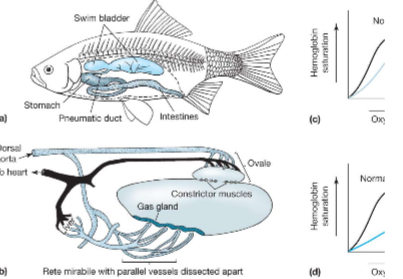
what is it called when the swim bladder is not connected to the intestine?
physoclistous

how do Chondrichthyes’ preform buoyancy?
sharks do not have swim bladder but preform buoyancy by the liver
liver makes up 25% body mass
what contribute to positive buoyancy in Chondrichthyes
urea
trimethylamine oxide
chlorine ions
nitrogenous compounds
what is the body internal environment determined by
ion concentration and temperature
what problem do freshwater fishes face to maintain their internal environment? marine water?
they have the tendance to gain water
marine have the opposite problem
What organ maintains the internal body environment what do they regulate?
kidney
they regulate ion concentrations
amounts of water
what is the process of maintaining the internal body environment called?
osmoregulation
Kidney functional and structural unit?
nephron
the nephron of the marine teleost is larger/smaller than the freshwater?
smaller
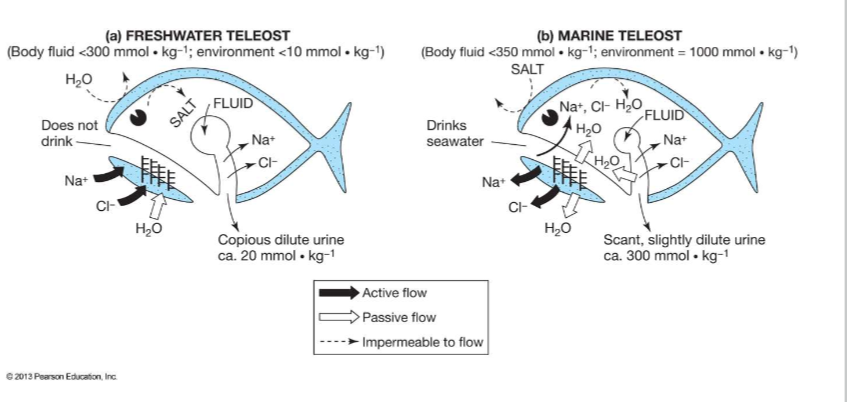
isosmolal fish
same salt concentration in the fish and the environment
hyposmolal fish
less salt in the fish than the environment